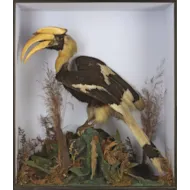Rare Victorian Specimen of a Great Hornbill ‘Buceros Bicornis’
A Rare Victorian Specimen of a Great Hornbill ‘Buceros Bicornis’
Contained in a glazed case with a label to the reverse reading ‘established 1834 William Hart & Son Bird and Beast Preservers, West End, Christchurch, Hants’
Mid 19th Century
Size: 100cm high, 86.5cm wide, 37.5cm deep – 39¼ ins high, 34 ins wide, 14¾ ins deep
See: Finch and Co catalogue no. 6, item no. 69, for a carved wooden Iban Dyak Great Hornbill ancestor figure
Contained in a glazed case with a label to the reverse reading ‘established 1834 William Hart & Son Bird and Beast Preservers, West End, Christchurch, Hants’
Mid 19th Century
Size: 100cm high, 86.5cm wide, 37.5cm deep – 39¼ ins high, 34 ins wide, 14¾ ins deep
See: Finch and Co catalogue no. 6, item no. 69, for a carved wooden Iban Dyak Great Hornbill ancestor figure
A Rare Victorian Specimen of a Great Hornbill ‘Buceros Bicornis’
Contained in a glazed case with a label to the reverse reading ‘established 1834 William Hart & Son Bird and Beast Preservers, West End, Christchurch, Hants’
Mid 19th Century
Size: 100cm high, 86.5cm wide, 37.5cm deep – 39¼ ins high, 34 ins wide, 14¾ ins deep
Contained in a glazed case with a label to the reverse reading ‘established 1834 William Hart & Son Bird and Beast Preservers, West End, Christchurch, Hants’
Mid 19th Century
Size: 100cm high, 86.5cm wide, 37.5cm deep – 39¼ ins high, 34 ins wide, 14¾ ins deep
The Great Hornbill is an enormous bird living in heavy rainforests ranging throughout South Eastern Asia, from Western India to Indo-China, and South through Malaya to Sumatra. Its tail often reaches 3 foot in length and their over large down curved bills surmounted by a grotesque horny casque are the hornbill’s hallmark. They fly strongly, alternating a series of slow heavy wing beats with short sailing glides that are audible for some distance.
Hornbills are intriguing and fascinating birds with unique habits, and the most peculiar of all their idiosyncrasies are their nesting habits. They are believed to pair for life and mostly nest in natural tree cavities or enlarged woodpecker holes. When the female is ready to lay she goes into the hole and is sealed in for the duration. They both work together to plaster up the hole with a combination of mud, dirt and regurgitated matter, the female from within and the male from without, leaving a narrow slit in the centre just wide enough for the female to poke her bill through. As a defensive measure against the raids of monkeys and tree snakes this device is uniquely effective. The female remains in the nest throughout the entire incubation period and until the young are at least half grown; a minimum of 6 weeks and sometimes up to 3 months. The burden on her faithful mate to keep her and offspring fed increases as the young grow and usually when the nestlings are half grown the male and female chip enough of the hard entrance block away for her to get out and assist him in the search for suitable fruits, berries and insects. Amazingly the young birds frequently plaster up the hole again from the inside having just enough room for food to be passed into them.
Because of these unique nesting habits, and their martial fidelity, hornbills are highly regarded by indigenous peoples who make and use symbolic representations of the bird in ritual ceremonies, and prize the horny bill for its amuletic properties.
Hornbills are intriguing and fascinating birds with unique habits, and the most peculiar of all their idiosyncrasies are their nesting habits. They are believed to pair for life and mostly nest in natural tree cavities or enlarged woodpecker holes. When the female is ready to lay she goes into the hole and is sealed in for the duration. They both work together to plaster up the hole with a combination of mud, dirt and regurgitated matter, the female from within and the male from without, leaving a narrow slit in the centre just wide enough for the female to poke her bill through. As a defensive measure against the raids of monkeys and tree snakes this device is uniquely effective. The female remains in the nest throughout the entire incubation period and until the young are at least half grown; a minimum of 6 weeks and sometimes up to 3 months. The burden on her faithful mate to keep her and offspring fed increases as the young grow and usually when the nestlings are half grown the male and female chip enough of the hard entrance block away for her to get out and assist him in the search for suitable fruits, berries and insects. Amazingly the young birds frequently plaster up the hole again from the inside having just enough room for food to be passed into them.
Because of these unique nesting habits, and their martial fidelity, hornbills are highly regarded by indigenous peoples who make and use symbolic representations of the bird in ritual ceremonies, and prize the horny bill for its amuletic properties.
Rare Victorian Specimen of a Great Hornbill ‘Buceros Bicornis’

SOLD


